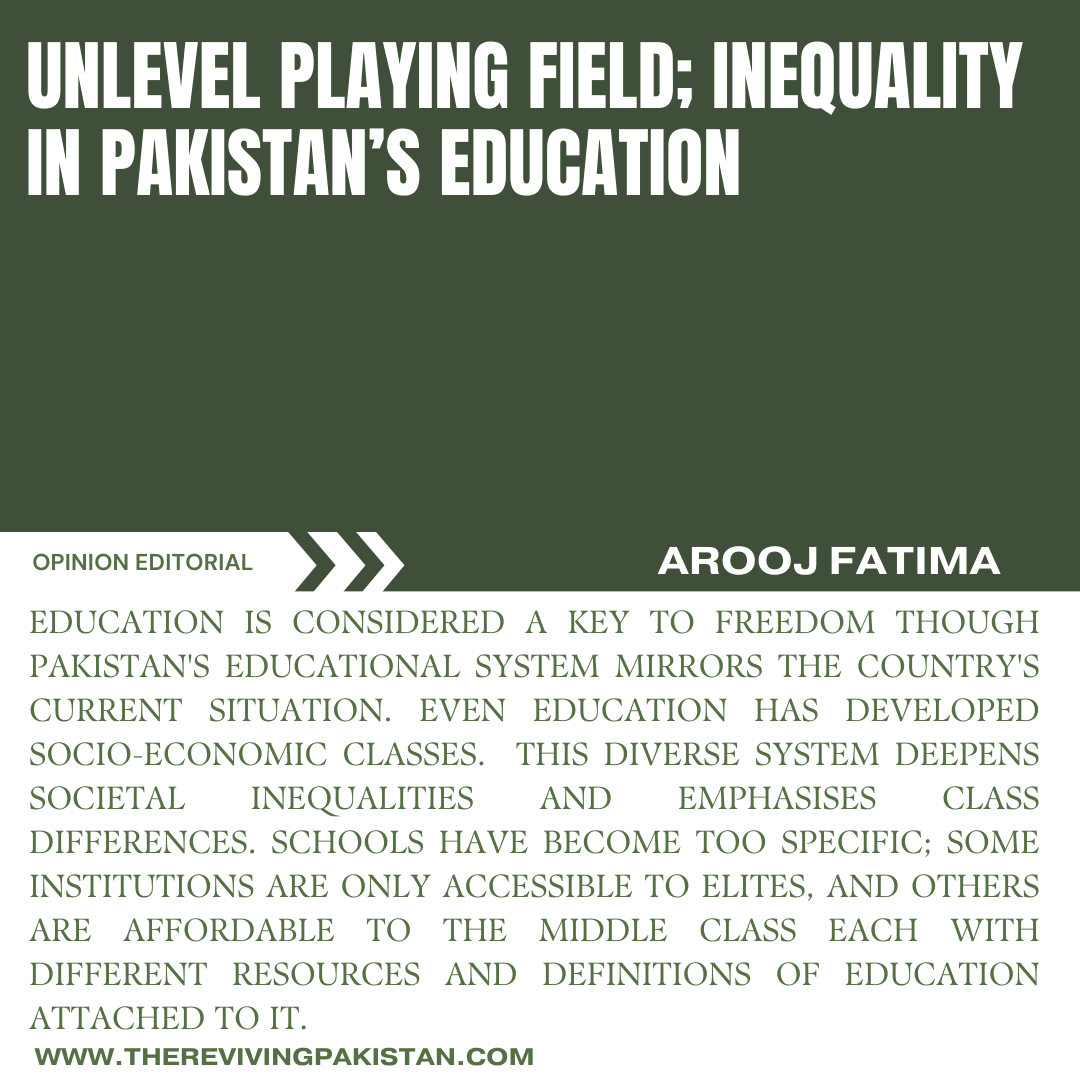About the Author(s)
Arooj Fatima is a dedicated writer and researcher currently working in Burak News, a newly launched digital platform. Focusing on Pakistan’s social and political landscape, she offers insightful analysis of national issues. She is leveraging her expertise and keen understanding of the country’s dynamics.
Education is considered a key to freedom, though Pakistan’s educational system mirrors the country’s current situation. Even education has developed socio-economic classes. This diverse system deepens societal inequalities and emphasises class differences. Schools have become too specific; some institutions are only accessible to elites, and others are affordable to the middle class, each with different resources and definitions of education attached to it. The current education system is categorized into three sectors: the private sector catering to the elites, the government sector facing instability and the madrassah, whose students find it very impossible to adjust to the current academic race.
In the Constitution of Pakistan, education is considered a fundamental human right. The government is obliged to provide free education to all children between ages 5 to 16. According to the Pakistan Education Statistics Report 2021-22, Pakistan has 26.2 million out-of-school children, representing 39 per cent of the total number of children in the country. Of those who go to school, over 40% of them study in private schools. Government schools in Pakistan have been left far behind in the race for education. They do not have the appropriate tools such as equipped labs and sometimes even skilful teachers, or no teachers at all, for certain subjects. The “Ghost School” scandal served as the perfect example of this. A report in 2020 revealed that there were about thirty thousand ghost schools in Pakistan. Schools that exist only on paper. The teachers continued to draw salaries, but these schools were empty buildings with no students.
Private schools have become a necessity. Every parent who desires an authentic, good and high-quality education for their children, opts to send them to private schools that cater to their needs and provide better education than government schools. The private schooling system has also added a few more layers to the education system, each with different resources and definitions of education attached to it. Simply, the elites have various forms of education, which distinguishes them from others. They emphasise individuality and posh academic standards and cultivate a sense of prestige while preparing them for top universities and influential careers. These schools provide quality education on international standards, but the underprivileged middle class cannot afford them. They see low-fee private schools as a capable solution. In these institutions, children do not have access to well-trained teachers, educational technologies, and fair assessment facilities. Children might learn English, but they will lose their critical thinking skills.
Madrassas have also been part of Pakistan’s education system for a long with educational programmes like the examination of the Quran, Hadith, and Islamic beliefs. They also suffer from the challenge of extremism. Radical ideologies propagated in certain madrassas led to the misunderstanding and sectarian conflict between different religious and cultural groups. Another big problem with the madrassa is their lack of standardized education. Their only focus is on religious studies, not the subjects that should be taught to all children at an early age. Thus their scholars often don’t fit in with the students of other schools. A 2016 report by the Unified Countries Improvement Program stated Madrassa graduates in Pakistan face twice the challenges in employment than an average national. This concludes madrassas as an economic burden, as they rely on government sponsorships or charity to survive.
Pakistan Tehreek-e-Insaf government had introduced a single-nation curriculum under the slogan Eik Qaum, Eik Nisaab (One Nation, One Curriculum) in an attempt to bridge the gaps between education institutions in Pakistan, but it failed miserably. Critics argue that the SNC oversimplifies education, disregarding regional linguistic, cultural, and educational differences. The stark contrasts between the government schools, elite private schools, under-resourced private schools, and isolated madrassas underscore a deep-seated inequality that the SNC’s also failed to address. The argument is that without a fundamental restructuring of the education system that ensures equitable resource distribution and integrates diverse educational needs, true educational equity and societal progress will remain elusive. For education to genuinely serve as a tool for freedom and social mobility, comprehensive reform is essential—one that not only addresses the gaps between different sectors but also fosters an inclusive approach to learning that empowers every child regardless of their socio-economic status.

